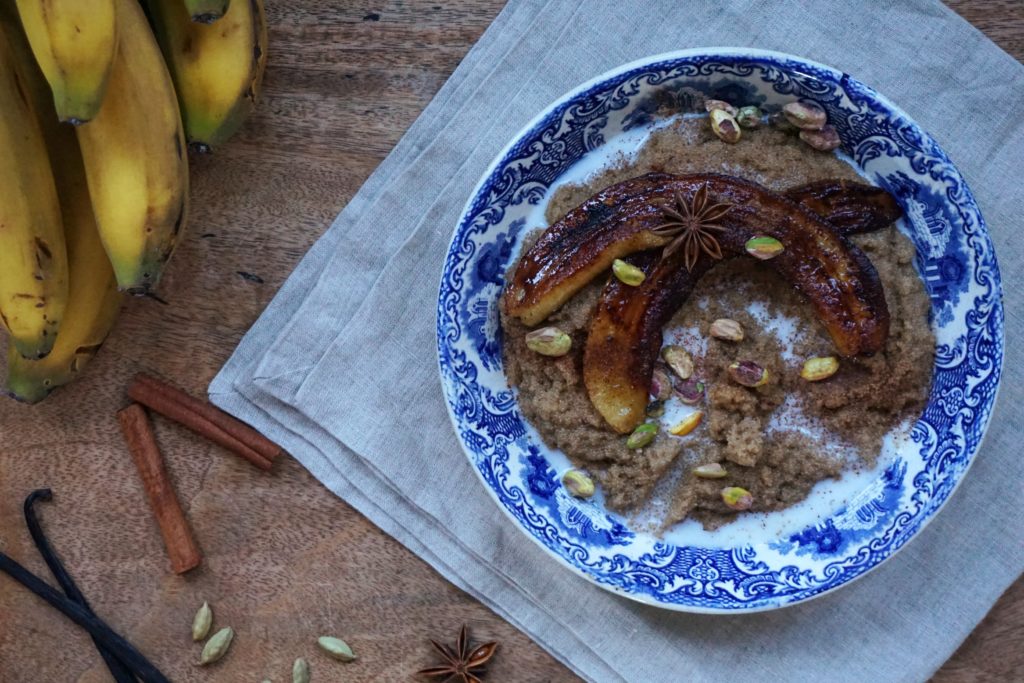Amaranth Recipe & Nutrition | ‘s Encyclopedia of Food

The amaranth plant, also known as African spinach, has a long history of being used in Africa to make bread and porridge. This nutritious and easily grown plant is also the key ingredient in making amaranth flour, which is high in fiber and protein. Amaranth flour is used for making home-made pancakes, breads, and muffins.
Amaranth is a grain that can be eaten as a whole grain, ground into flour, or made into flakes. It is high in fiber and has a mild flavor. Amaranth is a gluten-free grain that is higher in protein than other grains. It is considered a complete protein because it contains all 11 essential amino acids that the body cannot produce. Amaranth is a good source of dietary fiber. A 100 gram serving contains 101 calories, 3 grams of fat, 4.5 grams of protein, and 6 grams of dietary fiber.
Amaranth is a high-fiber, high-protein (yet low-fat and low-calorie) grain that is easy to grow, easy to use in your diet, and easy to prepare. Amaranth is also easy to cook: just add boiling water, heat for about 5 minutes (no need to boil), and serve with your choice of seasonings. Amaranth is a good source of protein and iron, and a good source of fiber and magnesium. Because of the high fiber content, amaranth can also help you feel full, so choose smaller portions.
A Quick Look
Despite its common classification as a grain, amaranth is really a gluten-free “pseudograin.” It originates from a flowering plant, like buckwheat and quinoa, rather than a grass. Amaranth has a long and illustrious history in Mexico, where it is believed to have originated. Amaranth was said to make up to to 80% of the Aztec diet before the Spanish invasion. Despite centuries of suppression by Spanish colonialists, amaranth finally made a return. It is still a significant nutritional and symbolic component of a typical Mexican meal today. It is also a significant crop in Africa due to its high nutritional value and drought resistance. The leaves, which are similar to spinach, may be eaten in addition to the grain-like seeds. Amaranth is a grain with a soft, chewy texture and a somewhat sweet, nutty taste. It contains a lot of plant-based protein, as well as manganese, phosphorus, magnesium, and iron.
Overview
You may not be acquainted with amaranth unless you are interested in “indie” grains or ancient Mexican history.
Despite its common classification as a grain, amaranth is really a gluten-free “pseudograin.” Pseudograins, unlike real grains, are derived from flowering plants rather than grasses; quinoa and buckwheat are two examples of pseudograins. These pseudograins are grouped alongside other cereals because they have nutritional characteristics and culinary applications that are comparable to genuine grains.
Amaranth is believed to have originated in Mexico, where it played a significant part in history. Amaranth was said to make up to to 80% of the Aztec diet before the Spanish invasion. Farmers would even give a part of their crops as a tribute to the gods during religious ceremonies since it was a staple meal. During the invasion, Spanish conquistadors ordered the destruction of amaranth farms and declared cultivating the plant illegal.
Fortunately, after centuries of suppression, amaranth has resurfaced. It is still a significant nutritional and symbolic component of a typical Mexican meal today. It’s eaten in porridges, soups, as a flour, or puffed like popcorn and combined with honey or chocolate to make delicious delights there.
Amaranth is now cultivated across the globe. It is a particularly significant crop in Africa because to its high nutritional value and drought resistance. The leaves, which are similar to spinach, may be eaten in addition to the grain-like seeds.
Identification
The seeds of amaranth are tiny, beige, and spherical. The seeds come from a lovely blooming shrub with a swarm of tiny magenta seed-bearing blooms that cluster together into thick, tassel-like projections. They have wide green or crimson leaves as well.
Amaranth that has been cooked is soft yet still chewy. The grains have a similar, spherical form to quinoa, but are smaller. Amaranth has a sweet, nutty, and somewhat grassy taste. Its taste may be used in both sweet and savory dishes.
Amaranth may also be popped in the same way as popcorn! It’s light and fluffy like popcorn in this form, but with a considerably smaller shape. It’s usually incorporated into dry cereals or pastries in this form to provide a crunchy, tactile aspect.
Nutritional Information
251 calories, 9.4 grams of protein, 3.9 grams of fat, 46 grams of carbs, and 5.2 grams of fiber are found in one cup of cooked amaranth (approximately 246 grams). Amaranth is a rich source of zinc, vitamin B6, vitamin B5, and folate, as well as a great supplier of manganese, phosphorus, magnesium, and iron.
Selection
Amaranth may be simple to obtain depending on where you are in the globe, or it may only be available at bigger, more progressive grocery shops, health food stores, and bulk food stores.
Amaranth is available as a whole grain, as well as puffed or crushed into flour.
In all instances, go to shops with a high product turnover and covered bins in bulk food stores. Look for amaranth that is dry, uniformly colored, and smells fresh and nutty. Pass it up if it smells too bitter or musty, or if there are indications of dampness.
Storage
Whole amaranth seeds should be stored in an airtight container in a cold, dry location. It may be stored in this manner for up to a year.
Because amaranth flour has a limited shelf life, it should be kept in the refrigerator or freezer to keep it fresh for four to six months.
Puffed amaranth still has a limited shelf life and should be kept carefully to prevent moisture exposure, which will cause the puff to deflate. It should be kept in an airtight container in a cold, dry location and consumed within a couple of months.
Cooked amaranth may be stored for up to a week in the refrigerator and up to six months in the freezer.
Preparation
Before consuming, amaranth seeds must be roasted or puffed. It may then be used as a foundation for hot or cold cereals, as well as thrown into soups and salads.
Here’s how you prepare it:
Add one cup of amaranth seeds to two and a half cups of water in a big saucepan. Bring to a boil, then lower to a low heat and continue to cook for approximately 20 minutes, or until the grains are fluffy and chewy and the liquid has been absorbed.
Simply add another half cup of water to the saucepan before boiling and simmer for another 10 minutes to get a softer, “porridge-like” consistency.
Amaranth may also be popped like popcorn. Preheat a pan over high heat and add one or two teaspoons of amaranth seeds at a time. As the seeds burst, keep stirring them with a spoon. Remove them from the pan after they have mostly popped. On its own, seasoned with spices, or as a crisp, airy topping, popped amaranth is delicious.
PISTACHIOS AND CARAMELIZED BANANAS IN SPICED AMARANTH PORRIDGE
Amaranth is a whole grain with a wonderful nutty taste and chewy texture that’s simple to cook. It’s used as the foundation for a porridge that’s been cooked in spiced milk and topped with caramelized banana and crunchy pistachios.
Ingredients
whey (dairy or non-dairy) 4 star anise* 1 star vanilla bean, split lengthwise* 2 cups cinnamon stick* 1 green cardamom pod, gently crushed* 1 tsp. salt 1 tsp. amaranth 1 cup butter or coconut oil, plus a little more to cook with bananas 1 tbsp honey or maple syrup 2 tsp banana, lengthwise sliced 1 teaspoon of coconut sugar 1 tablespoon pistachios For serving, 1/4 cup coconut milk or cream
Directions
Time to Prepare: 10 minutes 30 minutes to prepare 2 servings (about)
*If whole spices aren’t available, use 1/2 teaspoon cinnamon powder, 1/4 teaspoon cardamom powder, 1/4 teaspoon star anise powder, and 1 teaspoon vanilla essence instead.
Bring almond milk and entire spices to a simmer in a saucepan. Allow for 10 minutes of covered simmering. Then, using a slotted spoon, fish out all of the spices. (Skip this step if you used ground spices or extracts.)
Add the amaranth to the milk that is boiling. Cook for approximately 20 minutes, covered, stirring occasionally. Add a splash of water if the amaranth becomes too dry and sticks to the saucepan. Leave the lid off for a few minutes if it’s too moist. It’s done when the amaranth is soft yet chewy and has a creamy, porridge-like texture. Set it aside while you finish cooking the bananas.
In a nonstick skillet, melt butter or coconut oil over medium-high heat. Sprinkle both sides of the banana slices with coconut sugar, then put them in the skillet once the oil has started to boil. Cook for 3 minutes on one side or until golden brown and caramelized, then turn and cook for 1 minute on the other side. Remove the pan from the heat.
Divide the amaranth into two dishes and top with banana slices that have been caramelized. If desired, drizzle with coconut milk or cream and top with pistachios. Serve and savor while it’s still hot.
Book of Free Recipes
Every month, the Encyclopedia of Food grows as we include new delicacies and stunning food photography. Simply click this link to keep up with the latest news. Following that, we’ll give you a complimentary copy of our recipe book. We’ll also notify you when we introduce new and tasty items to the site.
For a free copy of the Encyclopedia of Food recipe book, go here.
Foods That Are Related
Amaranth is a staple grain that can be found in the form of flour and cooked whole. It is a gluten-free and gluten-rich grain that can be used in a variety of recipes for its nutritive properties.. Read more about amaranth porridge and let us know what you think.
Frequently Asked Questions
How do you eat amaranth?
Amaranth is a type of grain that can be eaten in many different ways. Some people eat it as a cereal, others use it to make flour for breads and pastries, and some cook it into a porridge-like dish.
Why is amaranth banned in the US?
Amaranth is banned in the US because it is a highly toxic plant that can cause serious health problems.
Is amaranth healthier than rice?
Amaranth is a type of grain, and it is healthier than rice.
Related Tags
This article broadly covered the following related topics:
- how to cook amaranth
- amaranth nutrition
- amaranth recipes
- amaranth recipes indian
- amaranth recipes dinner





